Have you ever tried using the Amazon Product Opportunity Explorer to discover new products for selling on the marketplace? What has been your experience so far?
The Product Opportunity Explorer is a powerful tool that assists Amazon sellers in finding new profitable products, analyzing demand, and making informed business decisions. By leveraging this tool, sellers can maintain a competitive edge and expand their businesses.
In recent news, Amazon has announced that Seller University will soon host a three-part webinar series on using the Product Opportunity Explorer to identify customer demand. This event is one you won’t want to miss. To optimize your business success, it’s advisable to gain a deeper understanding of this tool.
In our upcoming blog post, we will provide you with crucial insights, so be sure to read it through to the end.
Why Does A Seller Need To Find New Product Ideas?
Finding new product ideas is crucial for an Amazon seller for several reasons:
- Diversification: By offering a variety of products, sellers can cater to a wider audience. It can help to increase the customer base and maximize sales.
- Market Trends: Market trends change constantly. What’s popular today might not be in-demand tomorrow. Therefore, continuously finding new product ideas helps sellers stay relevant and competitive in the market.
- Business Growth: Introducing new products is a great way to expand the business and increase revenue. It opens up new market segments and opportunities for growth.
Remember, using tools like Amazon’s Product Opportunity Explorer can significantly assist in identifying potentially successful new product ideas based on current market demands and trends.
Watch these videos below about Product Opportunity Explorer:
Understanding the Amazon Product Opportunity Explorer
Is this tool available to all sellers?
You need to have a professional selling plan in order to access the Amazon Product Opportunity Explorer.
Role of the Product Opportunity Explorer in Product Research
Product Opportunity Explorer opens up a world of insights into Amazon customers’ search and buying habits. It’s your key to determining if there’s untapped customer demand waiting for you to address with new products. With this product research tool, you can delve into the most current and precise data about what customers are looking for and what’s currently available in the Amazon marketplace.
The Amazon Product Opportunity Explorer is a valuable tool for conducting product research. Here’s how it contributes to the process:

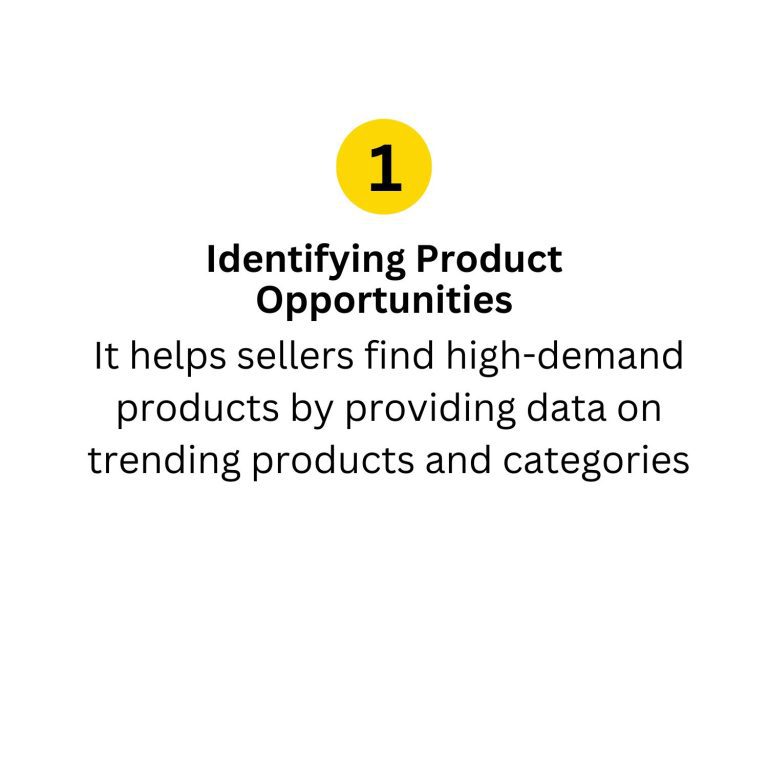

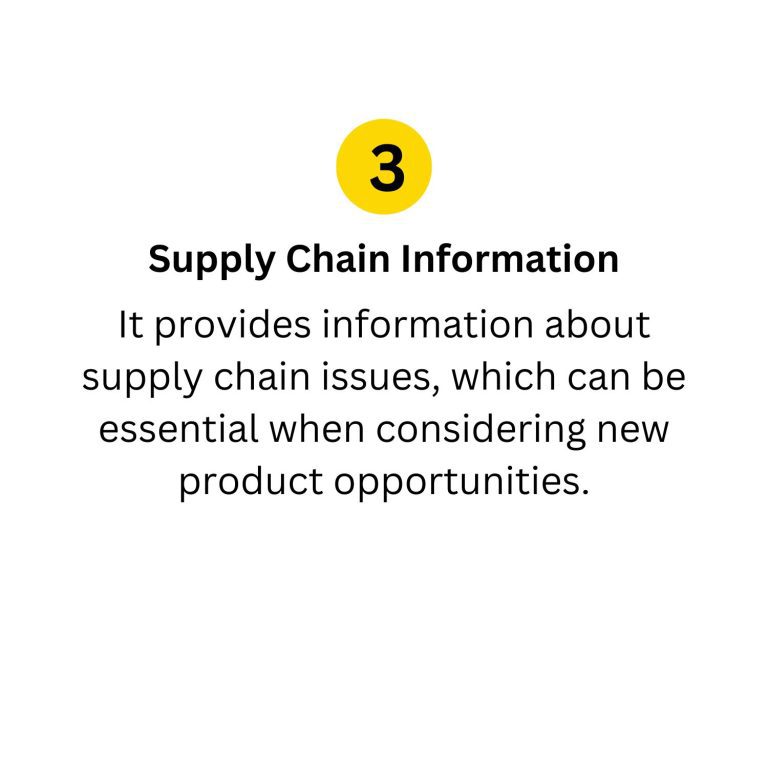
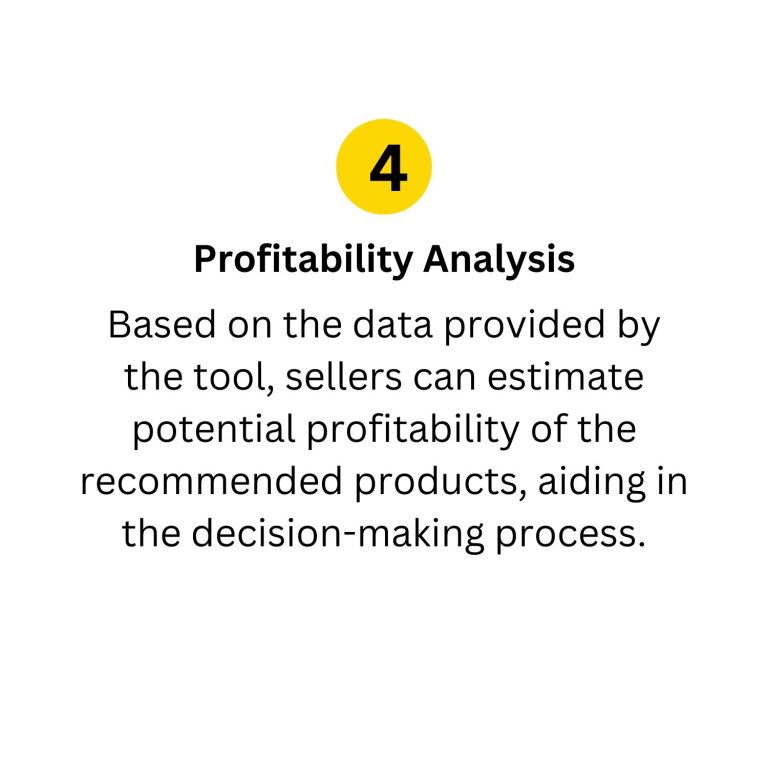
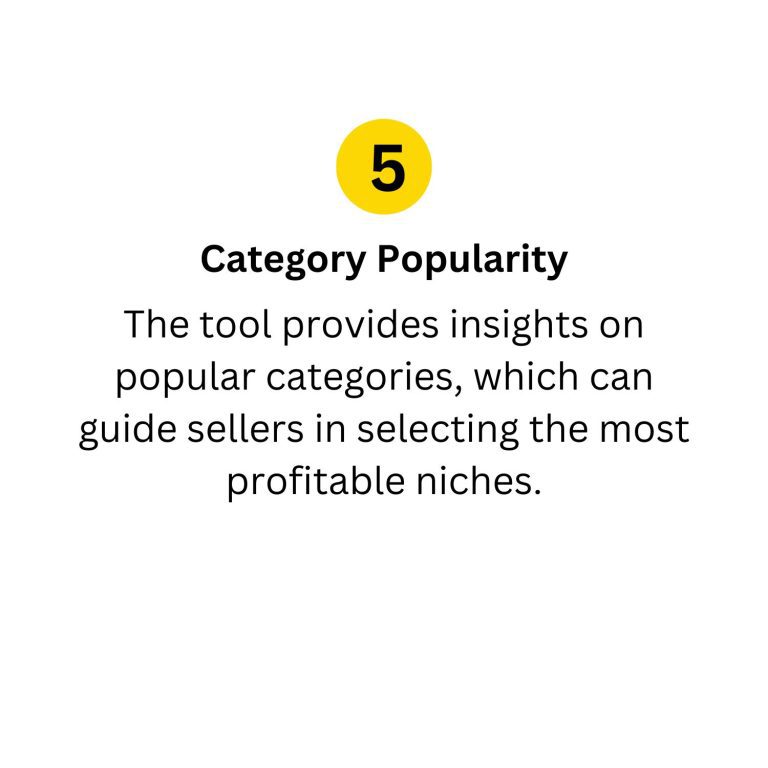
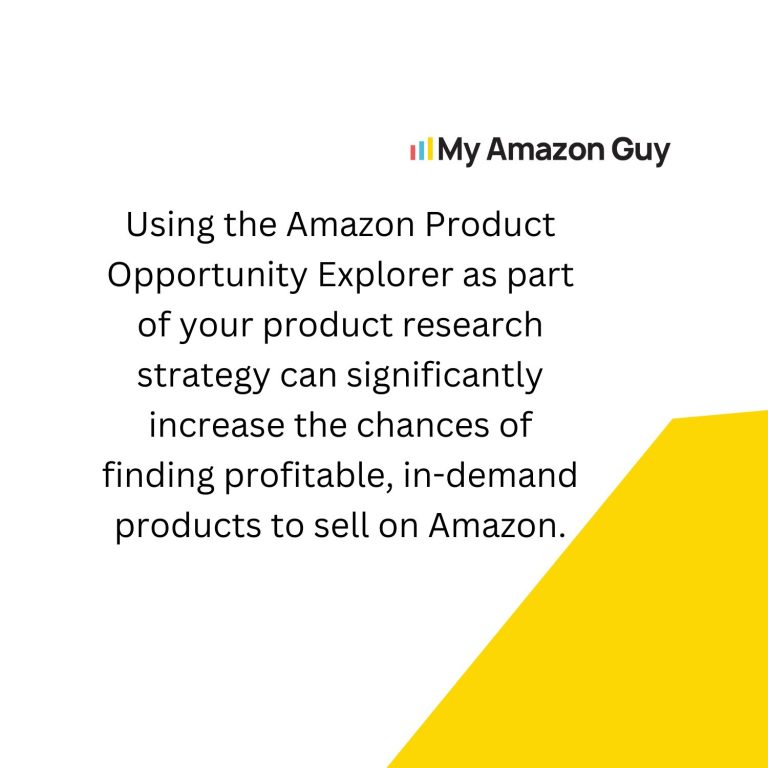
How to access the Product Opportunity Explorer?
In Seller Central, navigate to Growth > Product Opportunity Explorer.
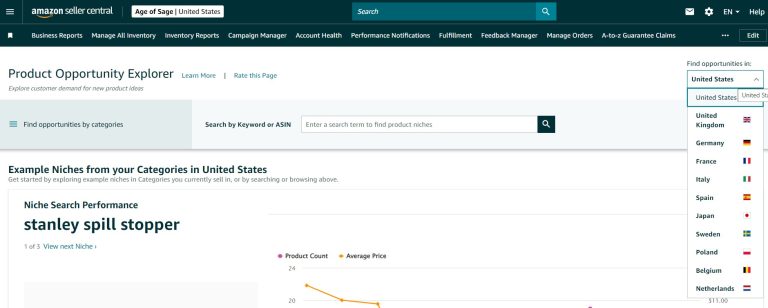
Here, you can search by categories, by keyword, or by ASIN.
You may also use this tool to find opportunities in US, UK, France, Germany, Spain, Italy, Sweden, Japan, Belgium, Poland, and Netherlands.
How Product Opportunity Explorer Works
The Product Opportunity Explorer utilizes niches as a strategic tool for identifying opportunities tailored to your business. A niche is essentially a curated set of customer search terms and products that cater to a particular customer need.
Within the tool, you have the flexibility to either browse or conduct searches to pinpoint niches that align with your business goals. These niches can then serve as valuable indicators for evaluating the potential success of introducing new products or services within that niche.
Each niche comes with a dedicated detail page that furnishes you with additional insights, including:
Current Products within the Niche – This helps you understand the existing competition within the niche.
Top Search Terms – Identifying the most frequently searched terms related to the niche can guide your product development and optimization strategies.
Statistics on Potential for New Product Launches – This data assists you in gauging the viability and potential success of launching new products within the chosen niche.
By leveraging these niche-specific details, you can make informed decisions and maximize your business’s growth potential on Amazon.
Amazon Product Opportunity Explorer: New Product Suggestions
Search New Product Ideas
You have two options with the Amazon Product Opportunity Explorer for this:
Explore Broader Customer Needs:
Start by searching for niches or categories that interest you, such as “dog bed.”
This approach allows you to uncover larger customer demands within specific niches or markets.
Direct ASIN Search:
Alternatively, you can directly search for specific ASINs (Amazon Standard Identification Numbers) of products you’re interested in.
This method provides you with detailed information about the particular product you’re researching.
Search for Niches
The Amazon Product Opportunity Explorer dashboard will also give you some insights about the increasing and decreasing searches by customers.

Explore niches that experience changes in the frequency of product searches. You can find these niches at the bottom of the homepage. Analyze customer search patterns by examining these niches.
Additionally, take advantage of the educational resources available from Seller University, conveniently located at the bottom of the page.
Navigating the Amazon Product Opportunity Explorer
Find Opportunities by Categories
This menu located in the top-left corner lets you navigate through the product categories. You can start from broader high-level groupings and narrow down to a specific category or subcategory.
When you opt for specific term searches, you are employing a top-down approach. Conversely, if you search by ASIN, you are employing a bottom-up strategy. By conducting an ASIN-based search, you gain the ability to compare your product with other products already available in the market.
Once you’ve chosen a category or subcategory, your search will generate a list of pertinent niches displayed on a results page. We gauge relevance based on text that aligns with your search terms as well as related search terms associated with niches. You have the option to examine your results in either Niche View or ASIN View.
Amazon Product Opportunity Explorer: Product Marketplace Guidance
The impact of marketplace guidance on sales
Marketplace guidance can significantly impact sales. Here are a few ways it can help:
- Product Expansion: As per the ‘Fastest Way To Grow Sales on Marketplaces Is To Add More Products’ data snippet from our database, adding more products can significantly boost your sales. It provides customers with more options and increases the likelihood of purchases.
- Financial Support: Some companies, like Payoneer, offer capital programs to help finance business advancements. This can support inventory expansion, marketing initiatives, and other growth strategies.
- Strategic Planning: Guidance can help you make informed decisions about product pricing, product selection, and marketing strategies. This can lead to improved sales performance.
- Improved Visibility: Marketplace guidance can help optimize product listings for better search visibility, potentially leading to increased sales.
- Customer Trust: Guidance can also provide insights into improving customer service and managing customer reviews, which builds trust and can lead to repeat purchases and increased sales.
Role of the Product Opportunity Explorer in marketplace guidance
The Product Opportunity Explorer plays a crucial role in marketplace guidance. Here are a few ways it can help:
- Identifying Potential Products: The Product Opportunity Explorer tool helps identify potential products that have high demand and low competition on the marketplace. This way, sellers can strategically add new products to their inventory to boost sales.
- Analyzing Market Trends: It provides insights into current market trends, allowing sellers to understand what products are trending and make informed decisions when adding new items to their catalog.
- Deciding Pricing Strategy: By providing data on typical price ranges for similar products, the tool can guide sellers in pricing their products competitively.
- Forecasting Sales: Based on the data it provides, sellers can forecast potential sales and make informed decisions about inventory management.
- Understanding Consumer Behavior: The tool can also provide insights into consumer behavior and preferences, which can assist in marketing and advertising efforts.
Amazon Product Opportunity Explorer: Product Demand Analysis
Importance of demand analysis for product selection.
Understanding demand metrics in the Product Opportunity Explorer is vital to make informed decisions about product offerings. Here’s what you need to know:
- Sales Demand: This metric shows the potential sales for a specific product category. A high sales demand indicates that a lot of customers are buying this type of product, making it a potentially profitable addition to your inventory.
- Search Volume: This is the number of times customers search for a specific product or category. High search volume indicates high customer interest and potential demand.
- Competition Level: While not a direct demand metric, understanding competition is crucial. If the competition is low but demand is high, it may indicate an excellent opportunity for sales.
- Historical Sales Data: Some tools provide historical sales data, which can help predict future demand trends. For example, if a product’s sales have been steadily increasing over time, it may indicate growing demand.
- Market Trends: Understanding market trends can also help gauge demand. If a product category is trending upwards, it may indicate increasing demand.
Watch Steven Pope, founder of My Amazon Guy, as he explains the top mistake to avoid in Amazon Product Research:
How the tool analyze product demand
The Product Opportunity Explorer tool analyzes product demand using several key factors. Here’s how it works:
- Sales Velocity: The tool looks at how quickly products are selling, which is a key indicator of demand. High sales velocity often points to high demand.
- Market Trends: It also examines market trends to understand what products are popular among consumers. This includes looking at seasonal trends, new product trends, and overall market growth.
- Demand and Supply Balance: The tool analyzes the balance between demand and supply for a specific product. If demand is high and supply is low, it’s usually a good opportunity.
- Customer Reviews and Ratings: High numbers of positive customer reviews and ratings can indicate high demand for a product, as these often reflect customer satisfaction and popularity.
- Search Volume: The tool can also look at search volume for specific keywords related to the product. High search volume often indicates high consumer interest and potential demand.
These factors combined give a comprehensive picture of product demand in the market. Remember, these metrics should be used together for a holistic view of product demand. Different products may have different demand metrics, and understanding these differences can help guide your product selection strategy.
Amazon Product Opportunity Explorer: Supply Chain Information
Role of supply chain information in choosing the best products to sell
Supply chain information plays a crucial role in choosing the best products to sell on online marketplaces. Here’s how:
- Inventory Management: Understanding your supply chain can help you manage your inventory efficiently. You can ensure that you have enough stock to meet demand, but not so much that you’re left with excess inventory.
- Lead Times: Knowing the lead times for your products can help you plan ahead and ensure you’re never out of stock. This can prevent sales losses due to stock-outs.
- Cost Assessment: Understanding the costs involved in your supply chain, including production, shipping, and storage, can help you price your products appropriately to maintain profitability.
- Product Quality: Supply chain information can help you ensure product quality. By working closely with your suppliers, you can prevent issues that could lead to negative reviews and returns.
- Demand Forecasting: If you understand your supply chain, you can better predict demand for your products. This can help you avoid overstocking or understocking.
Understanding supply chain woes via the tool
Amazon’s Product Opportunity Explorer can indirectly help address some supply chain issues by providing insights that can inform your supply chain strategy. Here’s how:
- Demand Forecasting: By providing data on market trends and product demand, the tool can help you anticipate future sales volumes. This can, in turn, allow for more accurate inventory planning and potentially reduce issues of overstocking or stockouts.
- Market Trends: Understanding market trends can help you plan for seasonal fluctuations in demand, allowing you to adjust your supply chain accordingly.
- Product Selection: The tool can guide you towards products with high demand and low competition. Focusing on these products can lead to faster inventory turnover, reducing the risk of holding costs associated with excess inventory.
- Pricing Strategy: The tool provides data on price ranges for similar products, helping to ensure your pricing is competitive. This insight can also inform decisions about which products are financially viable to sell, considering the costs involved in your supply chain.
- Consumer Behavior Insights: Understanding consumer behavior can help predict product demand, allowing for more accurate inventory management.
Importance of supply chain information for sellers.
Supply chain information is indeed crucial for sellers, particularly in the eCommerce sector. Here are some reasons why:
- Inventory Management: Understanding your supply chain can help you manage your inventory efficiently. It allows you to maintain the right stock levels to meet customer demand without overstocking.
- Meeting Customer Expectations: Supply chain information, including lead times, helps ensure that you can meet customer expectations for product availability and delivery times. This is essential for maintaining high customer satisfaction levels.
- Cost Control: Detailed knowledge of your supply chain can help you identify areas where costs can be reduced. This might be through improved logistics, bulk purchasing, or identifying alternative suppliers.
- Risk Management: Supply chain information can help you identify potential risks, such as a supplier’s ability to deliver on time, and develop contingency plans.
- Strategic Decision Making: Understanding your supply chain can inform strategic decisions, such as selecting new products, entering new markets, or adjusting pricing strategies based on cost fluctuations in the supply chain.
Amazon Product Opportunity Explorer: Search Volume Analysis
Role of search volume in product selection
- Demand Indication: High search volume for a particular product or keyword often indicates high consumer interest and potential demand, which can signal a good product to sell.
- Market Trends: Analyzing search volume over time can help identify trending products or categories, allowing you to capitalize on market trends.
- Keyword Optimization: Understanding what keywords have high search volumes can inform your product listings and SEO strategies, helping your products appear in relevant search results.
- Competition Assessment: High search volume can also indicate high competition. Understanding this can help you decide whether you can competitively offer the product and stand out among other sellers.
- Pricing Strategy: High search volume may indicate a willingness to pay a premium for a product, which can inform your pricing strategy.
How the tool analyzes search volume?
Amazon’s process for creating niches involves organizing search terms according to the products customers view or purchase following their searches. We establish clusters by identifying search terms that exhibit significant overlap in both purchases and clicks on ASINs.
Among these search terms, the one with the highest search volume within the cluster is designated as the niche. Please note that the number of search terms presented for a niche is currently limited, and this limitation is determined by the search terms with the highest search volume.
The Search Terms tab in the niche details page offers insights on customer intent and reviews product features or attributes that customers may regard as crucial for their search. In this section, you may also access and assess data like search volume, search conversion, click share, and also the top 3 clicked products.
Amazon Product Opportunity Explorer: Product Recommendations
Can Amazon Product Opportunity Explorer recommend profitable products to sell?
Yes, Amazon’s Product Opportunity Explorer can indeed help identify potentially profitable products to sell by:
- Demand and Competition Analysis: The tool identifies products with high demand and low competition. These products can often be sold at a premium, leading to potentially higher profits.
- Price Range Information: The tool provides information on typical price ranges for similar products, allowing you to assess potential profitability based on your cost structure.
- Product Category Insights: By reviewing the performance of different product categories, you can identify profitable niches to explore.
- Customer Behavior Insights: Understanding customer preferences and behavior can help you select products that are more likely to succeed and generate profits.
- Trend Analysis: The tool can identify trending products or categories, which may offer profitable opportunities due to increased demand.
Impact of product recommendations on sales
- Increased Sales: When customers see products that are relevant to their interests or needs, they are more likely to make additional purchases. This can significantly increase your overall sales.
- Improved Customer Experience: Personalized product recommendations can enhance the shopping experience, making customers more likely to return and make repeat purchases.
- Higher Average Order Value: Recommendations often lead to cross-selling or upselling, which can increase the average order value.
- Better Conversion Rates: Relevant product recommendations can improve conversion rates by encouraging customers to move from browsing to purchasing.
- Customer Retention: By showing customers that you understand their needs and interests, product recommendations can increase customer loyalty and retention.
Wondering if Amazon Product recommendations are good? Watch Steven in another video where he discusses the pros and cons of these recommendations.
Amazon Product Opportunity Explorer: Profitability Analysis
How Does Amazon Product Opportunity Explorer Help Maximize My Profits?
Amazon’s Product Opportunity Explorer can be a valuable tool for maximizing profits. Here’s how it can help:
- Identifying High-Demand Products: The tool helps identify products with high demand and low competition. These products can often be sold at a premium, potentially increasing your profit margins.
- Pricing Insights: The tool provides information on typical price ranges for similar products. This can help you price your products competitively while ensuring you maintain a profitable margin.
- Trend Analysis: By identifying trending products or categories, you can capitalize on increased demand, potentially leading to higher sales and profits.
- Customer Behavior Insights: Understanding customer behavior and preferences can help you select products that are more likely to succeed and generate profits.
- Inventory Management: By predicting demand, the tool can help you manage your inventory more efficiently. This can reduce costs associated with overstocking or understocking.
While the Product Opportunity Explorer can provide valuable insights, maximizing profits also depends on other factors like cost control, effective marketing, and exceptional customer service. It’s important to consider these aspects when developing your overall business strategy.
Here are additional videos you can watch to learn more about profitability on Amazon:
Amazon Product Opportunity Explorer FAQ
How often is the tool’s data updated?
New niches are generated monthly, starting at the beginning of each month, while metrics receive a refresh every week, commencing at the start of each new week.
Can I request more metrics? How?
While on any Niche details page, simply click on the ‘Request a Metric’ link located at the upper right corner of the page.
Follow the prompts to provide some essential information and submit the form.
Your requests for additional metrics aren’t confined to the specific detail page you’re currently on; you can propose metrics that would benefit any aspect of your experience with the Product Opportunity Explorer.
I am the primary user, and I’m encountering an error indicating insufficient permissions.
The Product Opportunity Explorer is accessible to Professional sellers in specific regions, including the US, Germany, UK, France, Italy, Spain, Japan, Netherlands, Poland, Belgium, and Sweden. If you meet these criteria, please verify that you are the original account registrant before reaching out to Selling Partner Support for assistance.
If you do not currently hold a Professional seller status, you can review the Selling Plan Comparison for more information. If you decide to upgrade to a Professional account, please allow up to 24 hours for access to the Product Opportunity Explorer to be granted.
It appears that my account has access, but this access is limited to the primary user. How can I extend access to other users?
By default, the Product Opportunity Explorer is made available exclusively to the primary user of each account. To grant access to additional users, follow these steps:
Navigate to ‘Settings.’
Select ‘Manage Global Permissions.’
Provide ‘View’ access for ‘New Product Opportunities.'”
This will allow you to share access with other users within your account.
How can I share feedback?
There are two ways to provide feedback. As you explore the Product Opportunity Explorer:
On each page, you’ll find the ‘Rate this page’ option located at the top left, next to ‘Learn More.’ Here, you can rate your satisfaction with the page and share your thoughts on what you appreciated or how it could be improved.
Alternatively, when you’re on a Niche details page, look for the ‘Is this Niche helpful?’ link next to the niche name. Clicking this link allows you to provide feedback specific to the niche you’re viewing, along with your overall satisfaction level regarding that niche. Your feedback is highly valuable and will be used by Amazon to enhance the overall utility of niches in the long run.
Amazon Product Opportunity Explorer: Best Practices
- Understand the Metrics: Familiarize yourself with the metrics used by the tool. These include search volume, growth, and trends over the last 90 days. Understanding these metrics helps in making informed decisions.
- Look for High Search Volume: Products with higher search volumes have a high potential for sales. They indicate that a lot of customers are looking for these products.
- Identify Growth Trends: Look for products that show positive growth trends. This indicates an increasing demand for these products which could imply a good selling opportunity.
- Consider Seasonality: Take into account the seasonality of products. The tool eliminates seasonality differences in its metrics, but as a seller, it’s important to factor this in your decision-making.
- Explore Different Categories: Don’t limit yourself to one category. Explore different categories to find diverse opportunities.
- Validate Product Opportunities: Once you identify potential opportunities, validate them. Research the competition, market demand, and profitability of these products before making any decisions.
Here are some additional tips:
- Be patient. Finding a profitable product takes time and effort. Don’t expect to find a winning product overnight. Be patient and persistent, and you’ll eventually find a product that meets your needs.
- Use Product Opportunity Explorer in conjunction with other tools. There are a number of other tools that can help you with product research, such as Jungle Scout, Helium 10, and Merchant Words. Use these tools together to get a more comprehensive view of a product opportunity.
- Stay up-to-date on trends. The market is constantly changing, so it’s important to stay up-to-date on trends. Use Product Opportunity Explorer to track trends and identify products that are gaining popularity.
- Don’t be afraid to experiment. There’s no surefire way to find a profitable product. Sometimes you need to experiment and try different things. Don’t be afraid to take risks and try new products.
Conclusion
Amazon Product Opportunity Explorer is a valuable tool for sellers to diversify their offerings and maximize sales. The tool can help sellers identify new opportunities, understand market trends, uncover less competitive niches, reduce seasonality risks, and validate product ideas.
However, it is important to remember that the Product Opportunity Explorer should be used in conjunction with other research methods and tools to make well-rounded decisions.





